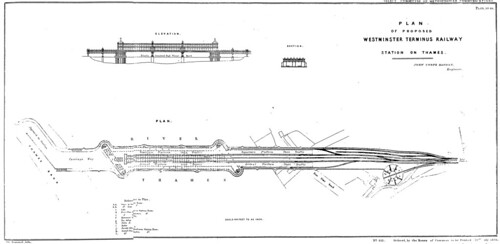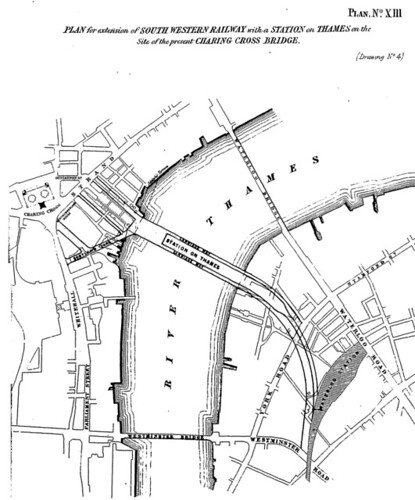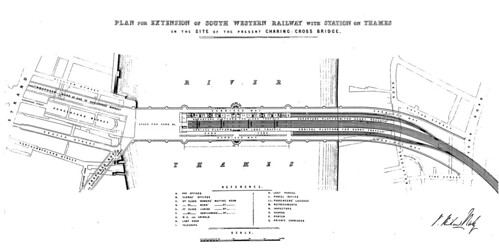Blackfriars railway station has recently become the first station to span right across the River Thames, with entrances on both sides of the river – but it wasn’t the first time that someone tried to put a railway bridge across the Thames.
There were a number of attempts, two notable ones which are quite interesting, and had they been completed, the railway history of the centre of London would have been very different.
The first, which actually came closer to being built was to be known as the Westminster Terminus Railway, which was planned to be a railway running from Clapham Junction with a major terminus station just around the corner from Parliament (route map). This was all before the two Victoria Stations were planned a bit further down the road.
The railway would also include a station at Pimlico which would have spanned the river and would have also included a walkway on the side to offer a pedestrian route across the river.
The railway was approved by Parliament in 1854, although it took until February 1856 for the Admiralty to approve the bridge across the Thames after concluding that it would not interfere with river traffic.
The purpose of the railway was to divert commuter traffic from Waterloo and London Bridge, where people were then forced to continue their journey by omnibus to Whitehall, causing considerable road congestion. Indeed, the railway was submitted as part of a wider review into London’s transport needs by a Parliamentary Committee in 1855.
The bridge/station was no mere idle fancy though, it’s location was specifically chosen to take advantage of passenger river traffic on the twopenny boats, and also cargo deliveries.
What is slightly curious about the railway though is that while it was designed to have a station within Westminster, and the bridge would be — as with Blackfriars — just a passing station, the plans submitted clearly show that it is a terminus, and there is no way trains would be able to proceed further. I can only presume they planned to build the bridge station first, and extend it into Westminster proper at a later date.
Sadly though, the whole scheme was abandoned just a year later as the Victoria Station & Pimlico Railway secured permission for its railway into the heart of Victoria.
The second railway would have had an even more dramatic impact on central London though — potentially affecting the entire Waterloo/Charing Cross complex of stations.
The South-Western Railway opened in 1848 what was at the time never intended to be a terminus station at Waterloo — called Waterloo Bridge — with the terminus expected to be much closer to the City of London.
During the 1855 hearings, plans were submitted by the railway to build an extension from Waterloo which would run over the Thames, replacing the Hungerford Bridge – which at the time was just a pedestrian bridge leading to the Hungerford food market.
The market would remain, but the bridge would be demolished and replaced with a much larger railway bridge, on which a terminus station would be constructed. As with its Pimlico counterpart, this would have entrances on both sides of the river, and a pedestrian pathway along the sides.
It’s worth noting that at the time the Hungerford footbridge was privately owned and charged a toll for use, of one half-penny per person to cross it, bringing in around £6,000 per year. One of the motivations for the politicians in considering a railway station across the Thames is that the pedestrian toll could be abolished as a condition of the railway getting its new station.
By extending the railway from Waterloo to the north side of the river, it was hoped that a good quantity of road traffic across Westminster and London Bridges could be curtailed.
The scheme was however not approved by the Committee and the railway company directed more efforts into upgrading Waterloo instead.
However, less than 10 years later, the footbridge had indeed been replaced by a railway, but this time it also destroyed the Hungerford market, which sat on the site of today’s Charing Cross Station.
It is possible that had the earlier station over the river been approved, then what is today Charing Cross may have ended up as the terminus for the South-Western Railway, and a station the size of Waterloo would now sit where Charing Cross is, and Waterloo might not even exist.
But we will never know.
Two river spanning railway stations proposed in 1855 never came to pass, and it wasn’t until 2012 that London finally got its first railway station that would straddle the two embankments of the Thames.











Did you know that Robert Stephenson originally thought about having the London to Birmingham Railway terminate at the Hungerford Market site ? This would have made a huge difference to London (including the need to demolish St Martins in the Field). Plan was too expensive, and so they ended up terminating the railway at Euston instead.
I love stuff like this. It’s always annoyed me that the SE and SW railways never got their act together and had a single terminus. I realise they were fierce competitors but it seems ridiculous that Charing Cross and Waterloo East exist either side of Waterloo proper.